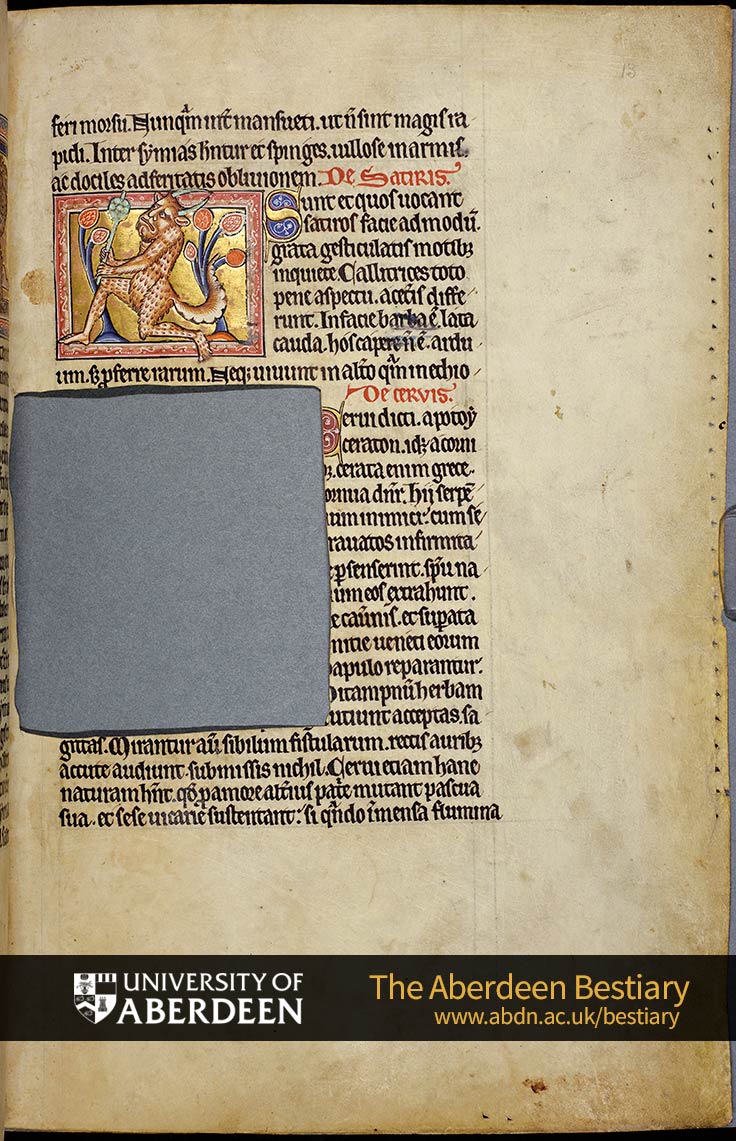Folio 13r - Apes, continued. De satiris; satyrs. De cervis; deer
bite fiercely. They are never so tame, that their ferocity does not increase. Sphynxes are also included among apes. They have shaggy hair on their arms and are easily taught to forget their wild nature. Of satyrs There are also apes that men call satyrs. They have quite attractive faces, and are restless, making pantomimed gestures. The apes called callitrices differ from the others in almost every aspect of their appearance. They have bearded faces and broad tails. It is not difficult to catch them but they rarely survive in captivity. They do not live elsewhere than under the Ethiopian sky, that is their native sky. Of deer The word cervi (deer) comes from ceraton, 'horns', for horns are called cerata in Greek. Deer are the enemies of snakes; when they feel weighed down with weakness, they draw snakes from their holes with the breath of their noses and, overcoming the fatal nature of their venom, eat them and are restored. They have shown the value of the herb dittany, for after feeding on it, they shake out the arrows which have lodged in them. Deer marvel at the sound of the pipes; their hearing is keen when their ears are pricked but they hear nothing when their ears are lowered. Deer have this characteristic also, that they change their feeding-ground for love of another country, and in doing so, they support each other. When they cross great rivers
- Commentary
-
Commentary
Text
Satyrs. Deer.
Illustration
The satyr, like the ape, has some similarities with man. He is partly like a goat with a beard, horns, and broad tail. His rather human body is covered with shaggy hair. He holds his thyrsus or wand, used in his lustful and disorderly revels. His face is quite attractive and he makes pantomime gestures.
Comment
Below him the illustration of a hart has been excised. In the centre of the lower margin is a very faint 'c', indicating the start of the next quire. Pricking and ruling are visible. Initial indicator 'c' in right margin. Initial type 2.
Folio Attributes
- Transcription and Translation
-
Transcription
feri morsu. Nunquam inter [A: ita] mansueti, ut non sint magis ra\pidi. Inter symias habentur et spinges, villose in armis\ ac dociles ad feritatis oblivionem.\ De Satiris\ Sunt et quos vocant\ satiros facie admodum\ grata, gesticulatis motibus\ inquiete. Callitrices toto\ pene aspectu, a ceteris diffe\runt. In facie barba est lata\ cauda. Hos capere non est ardu\um. Sed proferre rarum. Neque vivunt in altero quam in Ethio [excised, A: Ethiopico hoc est suo celo].\ De cervis\ Cervi dicti, apo ton\ ceraton, id est, a corni\bus, cerata enim grece\ cornua dicuntur. Hii serpen\tium inimici, cum se\ gravatos infirmita\te persenserint, spiritu na\rium eos extrahunt\ de cavernis et superata\ pernicie veneni eorum\ papulo reparantur.\ Ditampnum herbam\ [excised, A: ipsam prodiderunt eo nam pasci exc]utiunt acceptas sa\gittas. Mirantur autem sibilum fistularum, rectis auribus\ accute audiunt, submissis nichil. Cervi eciam hanc\ naturam habent, quod pro amore alterius patrie mutant pascua\ sua, et sese vicarie sustentant, si quando immensa flumina\Translation
bite fiercely. They are never so tame, that their ferocity does not increase. Sphynxes are also included among apes. They have shaggy hair on their arms and are easily taught to forget their wild nature. Of satyrs There are also apes that men call satyrs. They have quite attractive faces, and are restless, making pantomimed gestures. The apes called callitrices differ from the others in almost every aspect of their appearance. They have bearded faces and broad tails. It is not difficult to catch them but they rarely survive in captivity. They do not live elsewhere than under the Ethiopian sky, that is their native sky. Of deer The word cervi (deer) comes from ceraton, 'horns', for horns are called cerata in Greek. Deer are the enemies of snakes; when they feel weighed down with weakness, they draw snakes from their holes with the breath of their noses and, overcoming the fatal nature of their venom, eat them and are restored. They have shown the value of the herb dittany, for after feeding on it, they shake out the arrows which have lodged in them. Deer marvel at the sound of the pipes; their hearing is keen when their ears are pricked but they hear nothing when their ears are lowered. Deer have this characteristic also, that they change their feeding-ground for love of another country, and in doing so, they support each other. When they cross great rivers

